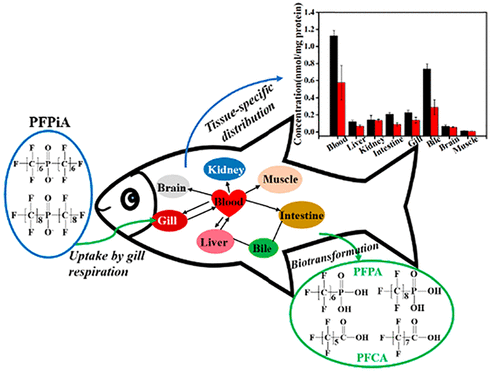当前位置:
X-MOL 学术
›
Environ. Sci. Technol.
›
论文详情
Our official English website, www.x-mol.net, welcomes your feedback! (Note: you will need to create a separate account there.)
Probing Mechanisms for the Tissue-Specific Distribution and Biotransformation of Perfluoroalkyl Phosphinic Acids in Common Carp (Cyprinus carpio).
Environmental Science & Technology ( IF 11.4 ) Pub Date : 2020-04-02 , DOI: 10.1021/acs.est.0c00359 Menglin Liu 1 , Fengfeng Dong 1 , Shujun Yi 1 , Yumin Zhu 1 , Jian Zhou 2 , Binbin Sun 1 , Guoqiang Shan 1 , Jianfeng Feng 1 , Lingyan Zhu 1
Environmental Science & Technology ( IF 11.4 ) Pub Date : 2020-04-02 , DOI: 10.1021/acs.est.0c00359 Menglin Liu 1 , Fengfeng Dong 1 , Shujun Yi 1 , Yumin Zhu 1 , Jian Zhou 2 , Binbin Sun 1 , Guoqiang Shan 1 , Jianfeng Feng 1 , Lingyan Zhu 1
Affiliation

|
This study investigated the tissue-specific accumulation and biotransformation of 6:6 and 8:8 perfluoroalkyl phosphinic acids (PFPiA) in common carp (Cyprinus carpio) during 90 d exposure and 30 d depuration in water in the laboratory. Both 6:6 and 8:8 PFPiAs could quickly accumulate in the carp, and 6:6 PFPiA displayed higher bioaccumulation potential than 8:8 PFPiA. The highest concentrations of PFPiAs were observed in the blood, while the lowest were found in the muscle. The equilibrium dialysis experiment indicated that both PFPiAs had higher binding affinities with the proteins in the fish serum than in liver, which was supported by the molecular docking analysis. The results also indicated that 6:6 PFPiA had higher binding affinities with the serum and liver proteins than 8:8 PFPiA. These results suggested that the tissue-specific distribution of PFPiAs was highly dependent on the binding affinities with the specific proteins. Both in vivo and in vitro experiments consistently indicated that PFPiAs experienced biotransformation and produced perfluoroalkyl phosphonic acids (PFPAs), and biotransformation of 8:8 PFPiA was more active than 6:6 PFPiA. It was worth noting that perfluorohexanonate and perfluorooctanoic acids were identified in fish as metabolites after long-term exposure to PFPiAs for the first time.
中文翻译:

全鲤(Cyprinus carpio)中全氟烷基膦酸的组织特定分布和生物转化的探测机制。
这项研究调查了在实验室中90 d暴露和水中30 d净化期间鲤鱼(Cyprinus carpio)中6:6和8:8全氟烷基次膦酸(PFPiA)的组织特异性积累和生物转化。6:6和8:8 PFPiA都能在鲤鱼中快速积累,而6:6 PFPiA的生物蓄积潜力高于8:8 PFPiA。血液中PFPiAs的浓度最高,而肌肉中最低。平衡透析实验表明,两种PFPiA与鱼血清中的蛋白质相比,与肝脏中的蛋白质具有更高的结合亲和力,这通过分子对接分析得到支持。结果还表明,6:6 PFPiA与8:8 PFPiA具有更高的与血清和肝蛋白的结合亲和力。这些结果表明,PFPiAs的组织特异性分布高度依赖于与特定蛋白的结合亲和力。体内和体外实验均一致表明PFPiA经历了生物转化并产生了全氟烷基膦酸(PFPA),并且8:8 PFPiA的生物转化比6:6 PFPiA更具活性。值得注意的是,在第一次长期接触PFPiA后,鱼类中的全氟己酸和全氟辛酸被鉴定为代谢产物。
更新日期:2020-04-23
中文翻译:

全鲤(Cyprinus carpio)中全氟烷基膦酸的组织特定分布和生物转化的探测机制。
这项研究调查了在实验室中90 d暴露和水中30 d净化期间鲤鱼(Cyprinus carpio)中6:6和8:8全氟烷基次膦酸(PFPiA)的组织特异性积累和生物转化。6:6和8:8 PFPiA都能在鲤鱼中快速积累,而6:6 PFPiA的生物蓄积潜力高于8:8 PFPiA。血液中PFPiAs的浓度最高,而肌肉中最低。平衡透析实验表明,两种PFPiA与鱼血清中的蛋白质相比,与肝脏中的蛋白质具有更高的结合亲和力,这通过分子对接分析得到支持。结果还表明,6:6 PFPiA与8:8 PFPiA具有更高的与血清和肝蛋白的结合亲和力。这些结果表明,PFPiAs的组织特异性分布高度依赖于与特定蛋白的结合亲和力。体内和体外实验均一致表明PFPiA经历了生物转化并产生了全氟烷基膦酸(PFPA),并且8:8 PFPiA的生物转化比6:6 PFPiA更具活性。值得注意的是,在第一次长期接触PFPiA后,鱼类中的全氟己酸和全氟辛酸被鉴定为代谢产物。


























 京公网安备 11010802027423号
京公网安备 11010802027423号